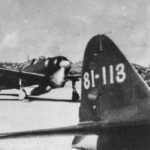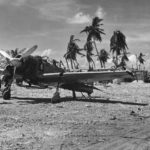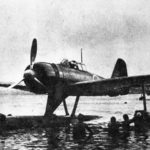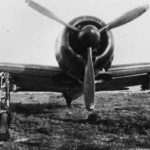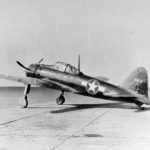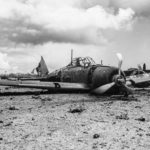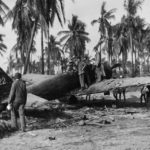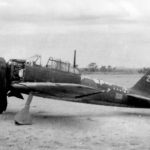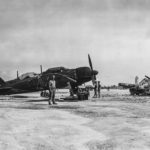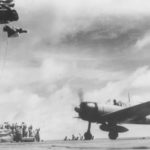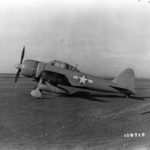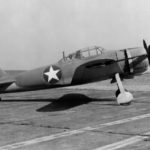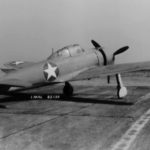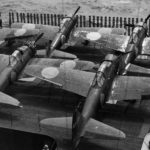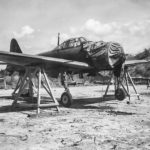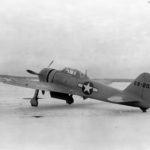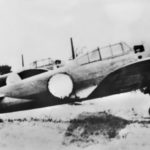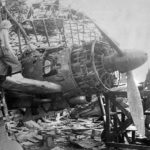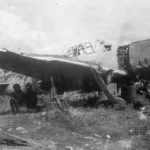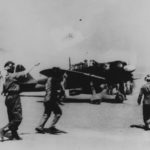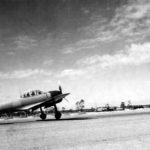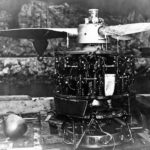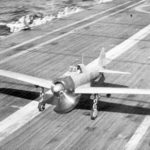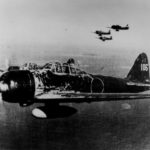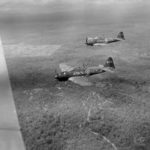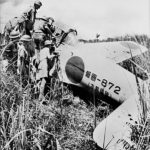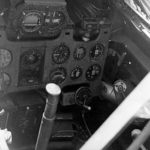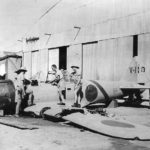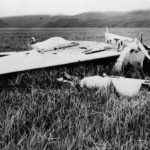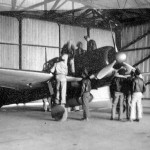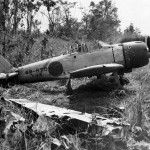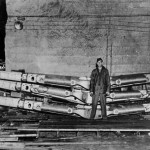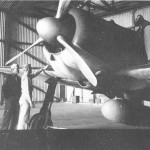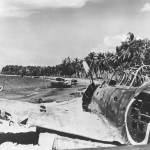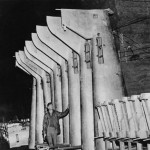Captured A6M2 EB-2, USA October 12, 1943 2
A6M5 Zero of the 381st Naval Air Group taking off
Wirraway QE-N of RAAF No 4 Squadron amid Wreckage of Zeros at Lae 1943
A6M5 61-120 Saipan July 8,a 1944
A6M5 Zero found in Marshall Islands
A6M “虎 159” of the 261 Kokutai Japan
A6M2-N
A6M5 Zero with Anti-Personnel Bombs 1944
A6M7 ヨD131 of the 302 Kokutai
A6M2 coded 114-6
A6M5 Zero with Anti-Personnel Bombs 1944 2
A6M2 EB-2 October 12, 1943
Reconstruction of Akutan A6M2 in San Diego 1942
Captured Tainan A6M2 Liuchow China 1941/1942
A6M Zero at Mokmer Drome Biak June 1944
A6M3 Zeke 32 built from 5 Zeroes from Buna at Wright field
A6M5 captured in Philippines January 1945
A6M 221-26 D of the 221 Kokutai
Lt Commander Sanders in the captured A6M2 from Akutan, 1942
Ki-46 and A6M 53-157 of the 253 Kokutai at Rabaul 2 November 1943. 345th BG strike photo.
A6M5 found in a hangar at Aslito Field Saipan in June 44
A6M5 and Marine F4U Corsair “184” Peleliu 1944
GI’s lounge on Nakajima A6M2-N wreck Attu May 1943
A6M5 Zero at Aslito Field Saipan 1944
A6M2 EII-111 take off from Zuikaku 23 January 1942
Marine Raiders in the Russell Islands examine the wreckage of downed A6M2 Model 21 (serial 6544) AI-I-129. Zero as piloted by Warrant Officer Katsuma Shigemi of the 14th Kokutai.
U.S. troops with intact Zeros at Aslito Airfield Saipan
A6M5 “虎-110” of the 261 Kokutai in Saipan hangar 1944
U.S. A6M3
A6M3 “イハ159” from Iwakuni Kokutai
Camouflaged A6M5 found on Saipan 1944
NACA Langley Research Center, Hampton Virginia 1943
A6M3 Zero tail wheel close up Buna 1943
USS Copahee with lineup of Mitsubishi A6M5 model 52 from Saipan
Captured A6M2, NACA Langley Research Center, Hampton Virginia, March 8, 1943
A6M5 aboard USS Copahee (CVE-12), Saipan July 1944
1st Marine Division Combat Photographer and A6M5 Peleliu
A6M5 code 8-17 from 261st Kokutai on blocks Saipan 1944
A6M2 with US markings in flight
A6M3 EB201 Wright Field
A6M2 code BI-12 ATAIU in flight
wreckage of A6M2 Model 21 Zeke from Hiryu after raid on Darwin 19 February 1942
RAAF A6M5 No 5622 Morotai 1945
A6M Zero 341-H-81 of 341 Kokutai 1945
Captured A6M5 Reisen #29 in flight – 1944
Destroyed A6M Marshall Islands
Japanese A6M Reisen of the Akagi carrier group 1941
A6M and D3A 1945
Mitsubishi A6M Reisen wreckage
A6M2-K two seat trainer
Mitsubishi A6M “Zero” of Kamikaze unit – Phillipines 1944
A6M Zero DI-108 Akutan 3
A6M Zero of Tainan Kokutai Buna New Guinea
Mitsubishi A6M5 Zero being fueled for mission Saipan 1944
A6M Eagle Farm airfield Brisbane Australia 1943
A6M Zero coded 61-131 Saipan 1944
A6M engine Nakajima Sakae 12 1942
A6M2 take-off during the Battle of Santa Cruz
A6M2 Zero USA 1943
Captured A6M2 P-5016 China
Abandoned A6M Zero fighter of 4th Kokutai
A6M 4th Kokutai Lae New Guinea in September 1943
A6M5 Zero Wrecked Philippines during 1945
Captured Japanese A6M5 Reisen in Australian markings 1945
A6M2 just before take off, IJN Carrier Akagi
A6M DI-108 Akutan 2
A6M3 Model 32 Hamp fighter of the 204th Kokutai, 1943
A6M3 code Q-102 “872” of the 2nd Kokutai – Papua July 1943
A6M3 Model 22 Zero fighters assigned to the 251st Kokutai
cockpit of a Japanese Mitsubishi A6M3 Papua 1943 3
Captured A6M 29 in flight
Mitsubishi A6M Zero Roi Island February 1944
A6M Zero Q-102 872 2nd Kokutai
Mitsubishi A6M3 Zero in flight over Brisbane
A6M Zero of 22nd Air Flotilla Kota Bharu Malaya 1942
Captured RAAF A6M Morotai 1945
Japanese A6M Zero 877 2nd Kokutai
US troops inspect wrecked A6M Zeros and Val at Munda Airport
Captured Nakajima Sakae 12 Engine from A6M Zero
A6M BII-120, IJN Carrier Hiryu, pilot Shigenori Nishikaichi
A6M2 in surrender markings Bougainville 1945
A6M5 Zero fighters Aslito Airfield Saipan
US troops inspect the wreckage of A6M5 Zero 8-13 on Saipan
A6M5 Zero of the RAAF
Captured A6M Zero fighters ATAIU-SEA
cockpit of a Japanese Mitsubishi A6M3 Papua 1943 2
A6M Reisen Q-102 1943 Buna
cockpit of a Japanese Mitsubishi A6M3 Papua 1943
Seabee Inspects Wing of Wrecked A6M Zero at Munda Airport
Wreckage of A6M Zero code V-110 of Tainan Kokutai forced down near Port Moresby 1942
A6M Zero Q-102 of 2nd Kokutai New Guinea
Lt Shindo’s Zero on carrier Akagi before raid on Pearl Harbor
Tail of a Mitsubishi A6M Zeke on Saipan 1944
captured A6M Zero 872
Japanese A6M DI-108 Zero Akutan
A6M Reisen P-5016 China
A6M2 Zero AI-154 was flown by Takeshi Hirano and crashed at Fort Kamehameha Pearl Harbor
A6M5 YoD-135 of 302nd Kokutai, Atsugi 1945 – color photo
A6M5 Zero 61-131 of 261st Kokutai Saipan
A6M2 Zero DI-108 Alaska 1942
Captured A6M2 Zero V-172
A6M Zero (Zeke) of the 261st Kokutai code 61-131 on Saipan 1944
Mitsubishi A6M Zero (Zeke) fighters
A6M Zero fighters captured on Saipan 1944
A6M5 Zero from 261 Kokutai 61-180 on Saipan 1944
A6M3 Zero (Hamp) at Buna 1943 V-187
A6M5 Zero (Zeke) Aslito Field Saipan 1944
Mitsubishi A6M Zero on carrier Akagi
A6M Zero factory in underground mine, Oya Japan 1945
Captured Mitsubishi A6M2 Zero V-172
Japanese Mitsubishi A6M Zero wreck at Guadalcanal Solomon Islands 1943
Mili Atoll Mitsubishi A6M Zero 381 Kokutai, POW and US sailor august 1945
A6M3 Zero Hamp at Buna 1943 Q-102
A6M Reisen fighters 61-197, 8-07, 8-33 and 8-36 of the 261st Kokutai – Saipan 1944
Captured A6M2 Zero V-172 front
A6M Zero 261 Kokutai on Saipan 1944
Mitsubishi A6M Zero 157 wreck
A6M5 Zero Saipan with M1 Carbine armed Marine 1944
Captured A6M2 Zero P5016
A6M3 Zero (Hamp) at Buna 1943
The cockpit interior of a A6M Zero Reisen V-172
Nakajima A6M2-N “Rufe” wreck on Attu Island Aleutians 1943
A6M5 Zero fighters found on Saipan 1944
Mitsubishi A6M fuselages
Captured A6M2 Zero V-172 engine
Captured A6M2 Zero V-172 landing gear
Mitsubishi A6M Reisen Zero (Zeke, Hamp) was a long-range navy fighter. Original japanese designation: Mitsubishi Navy Type 0 Carrier Fighter (零式艦上戦闘機 rei-shiki-kanjō-sentōki) or Mitsubishi Navy 12-shi carrier fighter. Production: 10939 units.
The A5M Claude had just entered service in early 1937 when the Japanese Imperial Navy began searching for a possible successor. By May, specifications for a new carrier fighter had been drawn up and passed on to Nakajima and Mitsubishi. The two companies began their work while awaiting further information.
Based on the experience of the A5M in China, the Japanese Navy issued additional specifications in October, requiring 500 km/h at 4,000 metres and an climb speed of 6,000 m in 9 min 5 s. They needed a range of 2 hours at normal power, which was to be increased to 6 or 8 hours at economy speed with additional tanks. The armament was to include two 20 mm cannons and two 7.7 mm machine guns, and the aircraft was to be able to carry two 30 or 60 kg bombs. All future Zeros were to be equipped with radio equipment. Finally, manoeuvrability had to be at least as good as with the A5M, while the wingspan had to be less than 12 m to be able to fit on aircraft carriers.
Nakajima found the new requirements impossible to meet, while Mitsubishi’s team leader Jirō Horikoshi, who had already designed the A5M Claude, agreed that they could be met on the sole condition that the aircraft be as light as possible. So, every effort was made to save weight and the designers made extensive use of a new aluminium alloy, Extra Super Duraluminium (ESD) developed by Sumitomo Metals.
The first prototype of the Mitsubishi A6M flew as early as April 1, 1939 and production began in July of the same year.
With excellent manoeuvrability, high firepower (in 1940) and a very long range, the initial superiority of the Zero and its exceptional range would weigh heavily on the balance when the Japanese chose to launch the attack on Pearl Harbor.
A6M1
In April 1938, the design offices of the Yokosuka Arsenal approved the 12 Shi fighter aircraft project and the construction of two prototypes was assigned to the aircraft producer Mitsubishi. The construction of the two prototypes, called A6M1/12 Shi, began in the summer of 1938. They were each equipped with a Mitsubishi Zuisei 13 engine of 780 hp, driving a two-blade propeller with variable pitch, but the engine did not give full satisfaction and this version, the first of the aircraft, was never produced in series. The Navy then suggested that the brand new 940 hp Nakajima Sakae 12 (NK1C) engine be fitted to two new prototypes. This engine was the equivalent of the Army’s Ha 25. The introduction of the new engine by far met the requirements of the original specification and the A6M2 model was ready for series production.
A6M2 model 11
The first fifteen copies of the pre-series were sent to China in July 1940 for evaluation in real field conditions. The engines of these aircraft tended to overheat. The problem had to be solved. While the aircraft had been designed to be used onboard, this first model was only going to be based on the mainland, so it was manufactured without its tail hook. The result was not long in coming, and the A6M2s swept everything in their path from the sky, so much so that the Chinese carefully avoided fighting the Zeros with their Polikarpov I-15 and I-16s. Westerners, who had the opportunity to take an interest in the Zero, continued to believe in the destitution of Japanese aviation. They were going to regret it.
A6M2 model 21
Because of their wingtips, the wingspan of the models 11 was disturbing for the manoeuvres in the elevators of the aircraft carriers, the first evolution of the Zero consisted thus in modifying the wing so that the wingtips are foldable: it will be the A6M2 model 21 (including 2nd type of airframe, 1st type of engine). Some details will evolve on the model 21, such as the appearance of an aileron counterweight to relieve the effort at high speed, a recurring problem on the Zero that will never really be corrected. This model, and most of the following models, was built with its tailhook. Located under the stabilizer, it was intended to stop the aircraft by hooking a arresting wires when landing on aircraft carriers.
A6M3 model 32 and 22
The A6M3 Model 32 was introduced in the spring of 1942 during the Battle of the Solomon Islands (Guadalcanal). Important modification: the 940 hp Nakajima Sakae 12 engine was replaced by a NK1F Sakae 21 or Ha-35-21, equipped with a two-speed supercharger delivering 1,130 hp at takeoff. This new, longer engine required the firewall to be moved 20 cm (8 inches) at the expense of fuel capacity. The engine cowling changed shape and the supercharger air intake was positioned at the top instead of the “tunnel” at the bottom. The guns had 100 shells each instead of the original 60. But the most noticeable change was the disappearance of the folding wing tips to improve the roll rate but also production. The Americans thought they were dealing with a new plane which they named Hamp instead of Zeke, but they quickly realized their mistake. The maximum speed went from 288 knots to 294 knots.
Production: at least 343 units
In an attempt to achieve a range comparable to the Model 21 following the increase in consumption of the Sakae 21 and the decrease in tank volume, Mitsubishi engineers installed two new 45-litre tanks in each wing. To maintain wing loading equivalent to Type 32, the folding wingtips were restored. Some 22 models received the 20 mm gun type 99 model 2 mark 3 with long barrel and improved rate of fire which one will find on the future versions. Three experimental models based in Rabaul used 30 mm cannons but no continuation will be given.
Production: 560 units
A6M4
In the end, there was no Series 4, the A6M4 had to use a turbocharger that was never fully developed. The Japanese had a lot of problems with turbochargers throughout the war.
A6M5
Still unable to develop the A7M Reppu (and especially struggling to make decisions), the Navy asked for an improved aircraft to make a junction that never took place. In August 1943, a Model 22 was modified by increasing the thickness of the wing skins, and reduced wing tip sizes were installed in a fixed position. In addition, the engine received separate exhaust pipes for propulsion. Although 70 kg heavier, the new Model 52 was 11 knots faster in level flight compared to the Model 32, but more importantly, its maximum dive speed was increased to 660 km/h. But these improvements were not enough and the Zero 52s were slaughtered by the Hellcats.
In March 1944, the Model 52 appeared on the front line. The further increase in the thickness of the surface allowed a dive speed of 740 km/h (the Corsair dive at 790 km/h). The mk4 guns received 125 shells each (instead of 100) by replacing the drums with belts.
The 52b model saw an improvement in the ability to take and return fire. A 50 mm armoured windscreen and tank extinguishers were installed. And a 13.2 mm Type 3 machine gun replaced one of the 7.7 mm.
The Model 52c was launched in emergency after the Battle of the Philippines. Despite the obsolescence of the airframe, it was necessary to improve the Zero because the production of the J2M Raiden did not start. The A6M5c incorporated back armour for the pilot, a self-sealing central tank and two 13.2 mm machine guns with 13.2 mm wings on the outside of the guns. The 7.7 mm machine gun on the cowling disappeared. The engineers asked the Navy for the right to install the larger Mitsubishi Kinsei engine to deal with the expected increase in weight. Once again, the Navy, by an incredible inertia, refused again and forced the Sakae 21 until the Sakae 31 was available, whose power had to be increased by injecting water and methanol. The performance collapsed.
A night fighter was developed from the model 52 by adding an angled gun in the fuselage. It was the A6M5d-S, S being the suffix of the night fighters (example J1N1-S Gekko).
Production: model 52: more than 747 units, model 52a: more than 391 units, model 52b: 470 units, model 52c: 93 units.
A6M2-K
First training version, two-seater. The airframe was modified so that the cockpit and canopy could house an instructor and an apprentice pilot. The motorization remained the same as that of the other versions of A6M; in the armament, the wing cannons of 20 mm were removed and only the two 7,7 mm machine guns. 60 kg bombs could be carried under the wings during training, but when these aircraft were used as Kamikazes in 1945, the 60 kg bombs were replaced by a 250 kg bomb. The production was divided between 236 units made by Dai-Nijuichi Kaigun Kokusho at Ōmura (Sasebo) between November 1943 and August 1945 and 272 units were made by Hitachi Kokuki K. K. between May 1944 and August 1945. Production: 508 units.
A6M5-K
Second training version, of which only seven were made by Hitachi Kokuki K. K. between March and August 1945. Same motorization as the A6M5 and same armament as the previous training version (A6M2-K): two 7.7 mm machine guns and two 60 kg bombs.
A6M6
The prototype of the A6M6 (Zero 53) flew in November 1944. In addition to the Sakae 31 engine (whose power greater than the 1,130 hp of the Sakae 21 is not mentioned in any book), the 45 l wing tanks received a self-sealing coating. The maximum speed of 300 knots (5 less than the 52), using water injection, was only theoretical, as the quality of engine and airframe manufacture was dangerously low due to the lack of quality raw materials and the lack of skilled labour. Skilled workers were recruited into the army. Moreover, the B-29 Superfortress raids on the engine factories were not going to help.
Production: only one prototype, according to some sources.
A6M7
The combat units modified the central tank racks to hold a 250 kg bomb on the previous versions. This will be standard on the A6M7 model 63.
Intended to be used as a dive bomber, the Model 63 had a bomb holder and attachment points for two 350-litre outer wing tanks and a tailplane with a thickened skin to resist stress. Production began in May 1945.
A6M8
As Nakajima was concentrating on producing the powerful 2,000 hp 18-cylinder Nakajima Homare engine, which had become a priority, production of the Nakajima Sakae had to be stopped slowly. Mitsubishi was then finally allowed to use the reliable and powerful 14-cylinder MK8P Mitsubishi Kinsei 62 [Ha-33]-62 engine with 1,560 hp.
This proven powerplant had been efficiently adapted to the Air Force Ki-100 and the Navy D4Y (from D4Y3 onwards). As the Kinsei was larger, it required a new cowling and the cowling machine gun disappeared. Since the beginning of the program, the power-to-weight ratio finally increased. The first prototype was finished in April 1945 and the encouraging results led the Navy to order no less than 6,300 A6M8s! However, none of them would see combat because the stagnation caused by the bombings and the shortage of materials had totally disrupted production. Prototypes of the A6M8 used 52c airframes, hence the name Zero 54, but the production models had to use the model 63 airframe, hence the name Zero 64.
Production: 6,300 planned, no production copies, 2 prototypes.
A6M2-N
Seaplane fighter plane. A float with an extra fuel tank was added under the fuselage, and each wing carried a smaller one under its underside. The Rufe, as it was code-named by the Allies, had the same armament as the other variants: two 7.7 mm machine guns on the cowling and two 20 mm guns, one in each wing.
Production: 327 units
Designed for attack, the Zero was a model of maneuverability and firepower and had a great autonomy in flight, an essential asset for the Japanese naval forces during the conquest phase and in the hands of the over-trained pilots at the beginning of the war it was very effective. But like many Japanese aircraft, its most important weaknesses were the lack of protection for the pilot and the self-sealing tanks, which increased the losses and then was an insurmountable handicap for the hastily trained pilots who found themselves in the front line as early as the autumn of 1942 following the losses of the Battle of Midway and the Guadalcanal campaign. On the last two versions, however, it benefited from some improvements but the results, due to a lack of mastery, were disappointing.
Many Zeros were also lost in battle as soon as the Allies abandoned dogfighting for the “yoyo” or “Thach Weave”, a tactic created by John Thach (horizontal or vertical maneuver, consisting of two aircraft to move away and then return, thus protecting the teammate by promoting the destruction of his pursuer) and the dive and zoom – dive attack then return – favorable to the American aircraft heavier by their armor and more powerful engines.
When the Americans mastered the Zero attack techniques, thanks in part to Akutan’s Zero, the ratio of 1 Japanese plane shot down for 1 American plane increased to 10 to 1.
However, the Japanese did not stay passive and launched new aircraft such as the Kawanishi N1K1-J Shiden (Purple Lightning) “George” and especially the excellent Nakajima Ki-84 Hayate “Frank”.
The first being a land-based version of a seaplane and the second, an Air Force fighter, they were the last symbols of the change of strategy in favour of ground-based aircraft, due to the lack of aircraft carriers.
Design and Structure
Type: Single-seat Naval Carrier-borne or Land-based Fighter
Wings:
- Configuration: Low-wing cantilever monoplane with a one-piece wing structure integrated with the forward fuselage.
- Structure: All-metal, two-spar structure with extruded booms and sheet webs. The wing has hydraulically-operated split trailing-edge flaps located between the ailerons and the fuselage.
Fuselage:
- Shape: Oval section, light alloy semi-monocoque structure divided into two sections at a vertical bulkhead aft of the cockpit. The forward section is built integrally with the wing, and the front and rear sections are joined by 80 bolts.
Tail Unit:
- Type: Cantilever monoplane with all-metal framework, metal-covered fixed surfaces, and fabric-covered control surfaces. The elevators have controllable trim-tabs, while the rudder has a ground-adjustable trim-tab.
Landing Gear:
- Type: Retractable with hydraulic retraction. Main wheels retract inward, with fairing plates on oleo legs and hinged doors closing the apertures under the wing. It features a partly retractable tail-wheel and a deck-arrester hook for carrier operations.
Power Plant
- Engine: Nakajima Sakae 21, a fourteen-cylinder radial air-cooled engine with a two-speed supercharger, capable of producing 1,020 hp at 6,400 ft, 885 hp at 15,700 ft, and 950 hp for take-off.
- Propeller: Mitsubishi-Hamilton three-blade constant-speed airscrew with a diameter of 10 ft (3.05 m).
- Fuel: Three unprotected fuel tanks (one in the fuselage and two in the wings) with a total capacity of 156 U.S. gallons. An additional 94 U.S. gallon jettisonable tank can be fitted under the fuselage.
Accommodation
- Cockpit: Enclosed cockpit positioned over the wing center, without pilot armor, bulletproof windscreen, or emergency release for the canopy.
Armament and Equipment
- Guns: Two 7.7 mm machine guns (similar to .303 in Vickers Mk. V) in the cowling, synchronized to fire through the airscrew. Additionally, two 20 mm Japanese-built Oerlikon cannons are installed in the wings.
- Bombs: Provision for carrying one 132 lb (60 kg) bomb under each wing for air-to-air bombing attacks.
- Additional Equipment: Flotation system with watertight compartments in each wing and a canvas bag in the rear fuselage for emergency flotation.
Dimensions
- Span: 36 ft. 2 in. (11 m)
- Length: 29 ft. 9 in. (9 m)
- Height: 9 ft. 2 in. (2.8 m)
- Wing Area: 238 sq. ft. (22.1 sq. m)
Weights and Loadings
- Empty Weight: 3,920 lbs. (1,780 kg)
- Normal Loaded Weight: 5,750 lbs. (2,610 kg)
- Maximum Permissible Weight: 6,330 lbs. (2,874 kg)
- Wing Loading: 24.2 lbs./sq. ft. (118 kg/sq. m)
- Power Loading: 5.63 lbs./hp (2.55 kg/hp)
Performance
- Maximum Speed: 340 mph (544 km/h) at 19,700 ft (6,000 m)
- Maximum Rate of Climb: 3,020 ft/min (920 m/min) at 8,000 ft (2,440 m)
Bibliography:
- Jiro Horikoshi – Eagles of Mitsubishi: The Story of the Zero Fighter
- Dan King – The Last Zero Fighter: Firsthand Accounts from WWII Japanese Naval Pilots
- Zero Fighter- Syoko Watanabe
- Mantelli, Brown, Kittel, Graf – Fighter Zero – Mitsubishi A6M, Aircraft of World War II Book 21
- Donald Nijoboer – Seafire vs A6M Zero: Pacific Theatre; Osprey Duel 16
- Don Greer – A6M Zero in Action – Squadron/Signal Publications Aircraft 59
- Edward Young Jim Laurier – F4F Wildcat vs A6M Zero-sen: Pacific Theater 1942, Osprey Duel 54
- Edward Young – F6F Hellcat vs A6M Zero-sen: Pacific Theater 1943-44 – Osprey Duel 62
- Mitsubishi A6M Zero Reisen model 11-22 – Famous Airplanes Of The World No 10, 6/1974
- Mitsubishi A6M Type Zero Carrier Fighter Model 11-21 – Famous Airplanes Of The World 55
- Mitsubishi A6M Type Zero Carrier Fighter Model 22-63 – Famous Airplanes Of The World 56
- Artur Juszczak – Mitsubishi A6M Zero, Mushroom Yellow Series 6103
- Mitsubishi A6M Zero Fighter, Aero Detail 7
- Modelling the Mitsubishi A6M Zero, Osprey Modelling 25
- Henry Sakaida – Imperial Japanese Navy Aces 1937-45; Osprey
- Richard M. Bueschel – Mitsubishi A6M1/2/-2N Zero-Sen in Japanese Naval Air Service; Schiffer Military/Aviation History
- C. Richards, Donald S. Smith – Mitsubishi A6M5 to A6M8 “Zero-Sen” (“Zeke 52”); Aircraft Profile 236
- Rene J. Francillon – The Mitsubishi A6M3 Zero-Sen (“Hamp”); Aircraft Profile 190
- Rene J. Francillon – Mitsubishi A6M2 Zero-Sen; Aircraft Profile 129
- Krzysztof Janowicz – A6M2-N Rufe, Kagero Famous Airplanes 4
- Robert C Mikesh – Zero: Combat and Development History of Japan’s Legendary Mitsubishi A6M Zero Fighter, Motorbooks International Warbird History
- Robert C Mikesh -Japanese Aircraft Code Names & Designations
- Robert C Mikesh – Zero Fighter
- JAMES D’ANGINA: Mitsubishi A6M Zero, Osprey Air Vanguard 19

